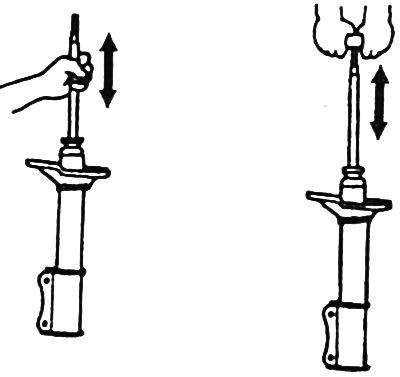Prolonged oscillation of the body with uneven thresholds.
Shaking of the body during successive bumps in the road.
The bouncing of the wheels is also on a flat road.
Car breakdown while braking (may also have other causes).
Danger when turning due to insufficient longitudinal stability, vehicle skidding.
Abnormal tire wear with smoothing (blurring) tread pattern.
During a trip, a shock absorber defect is also determined by rumbling noises and cod. However, such noises can often have other causes. They can be caused, for example, by loose bolts and nuts of the undercarriage, a defective wheel bearing, a constant velocity joint. Therefore, before replacing the old shock absorber, always check it, if necessary, do this on a shock absorber test stand.
The shock absorber can be checked manually. Accurate control of the ability of the shock absorber to accept the load is possible only with the use of a shock tester (without removing damper) or on a shock absorber test stand.
Checking the shock absorber manually
Remove shock absorber.

Keep the shock absorber in the same position as during installation, then stretch and compress it at least three times. Throughout the entire stroke, the shock absorber piston rod should mix equally hard and without jerks.
With a gas-filled shock absorber, with sufficient gas pressure, the piston rod automatically returns to its original position. If this does not happen, then this does not mean that the shock absorber must be replaced. The action of such a shock absorber corresponds to the action of a conventional shock absorber until increased oil loss begins. Damping is carried out to the full extent and without gas pressure, however, noise absorption is degraded.
When working flawlessly, slight traces of oil on the surface of the shock absorber are not grounds for replacing it. Rule of thumb: if the oil stain is obvious and extends no further than from the piston rod seal to the lower spring cup, then the shock absorber is fine. The prerequisite for this is that the oil stain is dull, dull or, due to dust, dried up. The slight oil escaping is even an advantage, as it keeps the O-ring lubricated and therefore lasts longer.
If there is a large loss of oil, replace the shock absorber.
Visitor comments